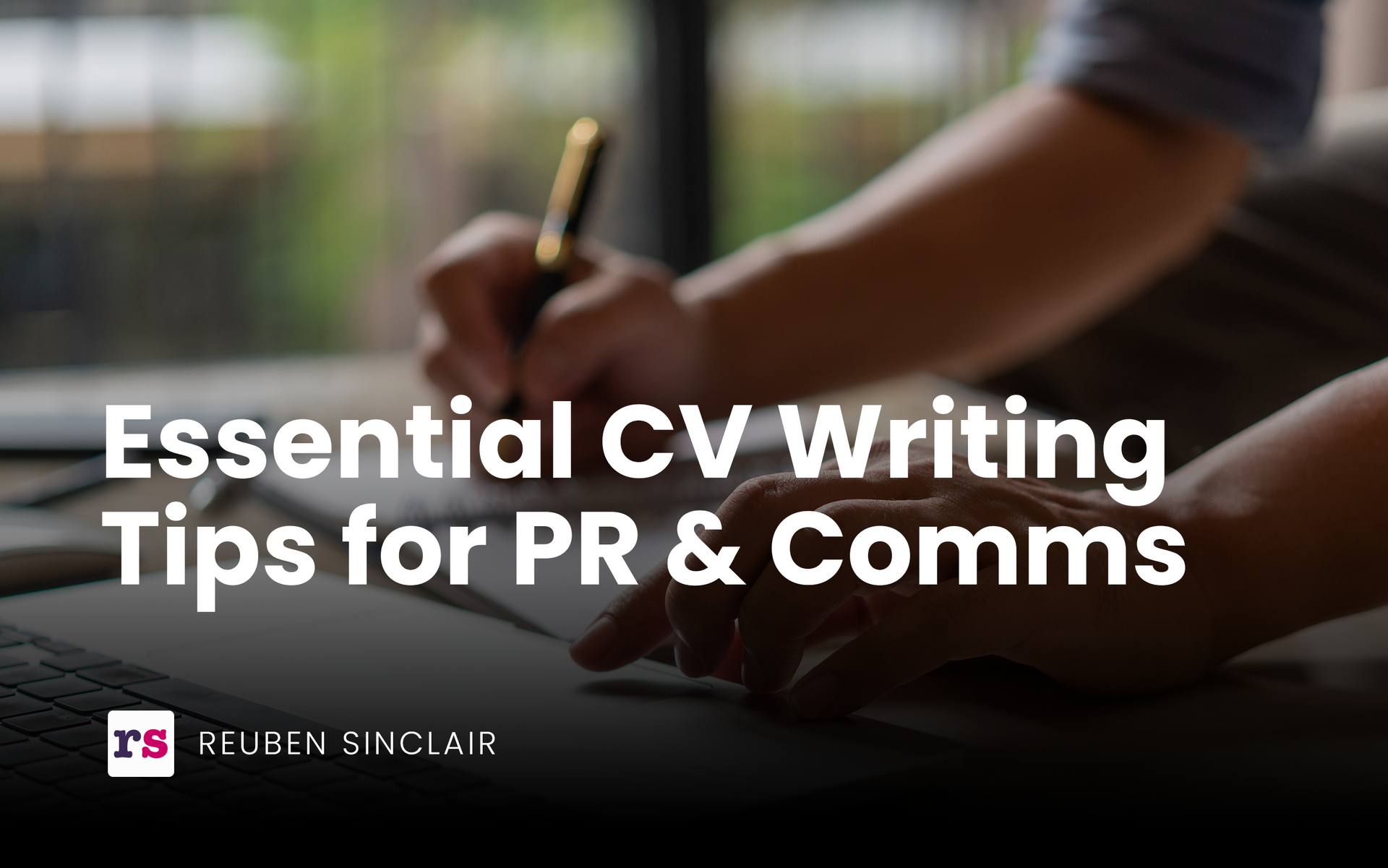Essential CV Writing Tips for PR & Communications: A Practical Guide for Junior and Mid-Level Applicants

For Public Relations (PR) & Communications, your CV is typically your first pitch.
Whether you’re a fresh graduate or climbing the career ladder, knowing how to tailor your CV for PR and Comms roles can make all the difference in your search for a new role. This guide will help you stand out from the crowd, showcasing your skills and experience in a way that resonates with potential employers. Let’s jump in.
1. Understand the PR & Comms Sector
Before you even begin writing, it’s essential to understand what employers in PR and Communications are looking for. The industry values creativity, adaptability, strong communication skills, and a knack for storytelling. Research the specific role you’re applying for and note the keywords and phrases used in job descriptions. Incorporate these into your CV to show that you’re not just applying broadly - you’re targeting this industry and role specifically.
Action Item:
- Spend time analysing 5-10 job postings in PR & Comms to identify common skills and qualifications. Create a list of keywords that frequently appear and make sure to weave these into your CV.
2. Write a Strong Personal Statement
Your personal statement is the elevator pitch of your CV. It’s the first thing recruiters will read, so it needs to be concise, compelling, and tailored to the PR & Comms sector. Highlight your passion for the industry, your relevant experience, and what makes you a unique candidate.
Structure to Follow:
- Introduction: Briefly introduce your current status (e.g., “A proactive PR professional with 3 years of experience…”).
- Value Proposition: Explain what you bring to the table (e.g., “Proven ability to craft engaging press releases and manage media relations…”).
- Objective: Clearly state what you’re looking to achieve (e.g., “Seeking a mid-level PR role where I can leverage my skills in content creation and media strategy…”).
Action Item:
- Write a 3-5 sentence personal statement that directly aligns your skills and experience with the specific requirements of the job you’re applying for.
3. Showcase Relevant Experience and Achievements
Your work experience section should do more than just list job duties - it should highlight achievements that demonstrate your impact in previous roles. Focus on results-driven bullet points that showcase your ability to generate media coverage, manage campaigns, or build brand awareness.
Example:
- Before: “Managed social media accounts for various clients.”
- After: “Increased client social media engagement by 30% through strategic content planning and execution.”
When detailing your experience, prioritise the roles and responsibilities that are most relevant to PR & Comms. For instance, if you’ve managed a successful PR campaign, make sure that stands out.
Action Item:
- Rewrite the bullet points under each job experience to focus on achievements and quantifiable results that align with the job you’re applying for.
4. Highlight Transferable Skills
If you’re transitioning into PR & Comms from another industry, emphasise your transferable skills. Strong communication abilities, project management, creativity, and analytical skills are all highly valued in PR and can be gained in various roles.
Key Transferable Skills:
- Writing and Editing: Essential for crafting press releases, speeches, and content.
- Project Management: Useful in coordinating campaigns and events.
- Data Analysis: Helps in measuring the success of PR strategies.
- Media Relations: Developing and maintaining relationships with journalists and influencers.
Action Item:
- Identify at least three transferable skills from your past roles and illustrate how they will help you succeed in a PR & Comms role.
5. Incorporate Industry-Specific Keywords
Many companies use Applicant Tracking Systems (ATS) to screen CVs. These systems look for specific keywords related to the job. To ensure your CV gets through, incorporate industry-specific terminology throughout your document.
Example Keywords:
- Media Relations
- Press Releases
- Brand Strategy
- Crisis Communication
- Social Media Management
- Content Creation
Action Item:
- Review the job description and insert relevant keywords naturally into your CV, especially in your personal statement, skills section, and job descriptions.
6. Emphasise Your Education and Certifications
While experience is critical, education and certifications can also play a significant role, especially for junior-level candidates. Highlight any relevant degrees (e.g., Communications, Journalism, Marketing) and certifications (e.g., HubSpot’s Content Marketing, PRSA’s APR).
Action Item:
List your education and any relevant certifications towards the bottom. If you have notable academic achievements, include them to strengthen this section.
7. Include a Skills Section Tailored to PR & Comms
A well-organised skills section can quickly convey your qualifications. List both hard skills (e.g., media monitoring, copywriting) and soft skills (e.g., relationship-building, problem-solving) that are essential for PR & Comms roles.
Example:
- Hard Skills: Media Monitoring, Press Release Writing, Crisis Management, SEO, Analytics.
- Soft Skills: Strategic Communication, Networking, Adaptability, Creativity.
Action Item:
- Create a skills section that aligns with the job description and your strengths. Aim for a mix of 5-7 hard and soft skills.
8. Optimise Your CV’s Design and Layout
In PR & Comms, presentation matters. Your CV should be clean, professional, and easy to read. Use a modern but simple layout, with clear headings and bullet points. Avoid overly fancy designs that could distract from the content.
Action Item:
- Choose a professional CV template that is ATS-friendly and ensure that your layout highlights your strengths and is easy to navigate.
Final Thoughts
Tailoring your CV for PR & Comms roles is about more than just listing your experiences - it’s about strategically showcasing your skills, achievements, and potential in a way that aligns with what employers are looking for. By following these steps, you’ll be well on your way to creating a CV that not only grabs attention but also propels you to the next stage of your career.
Remember, your CV is your first opportunity to communicate your story - make it count!
Do keep an eye out for a future post where we break down a winning CV success story.
Need help tailoring your CV for PR & Comms roles? Feel free to reach out to us, and let’s get you noticed by the right people!
Action Item Summary
- Spend time analysing 5-10 job postings in PR & Comms to identify common skills and qualifications. Create a list of keywords that frequently appear and make sure to weave these into your CV.
- Write a 3-5 sentence personal statement that directly aligns your skills and experience with the specific requirements of the job you’re applying for.
- Rewrite the bullet points under each job experience to focus on achievements and quantifiable results that align with the job you’re applying for.
- Identify at least three transferable skills from your past roles and illustrate how they will help you succeed in a PR & Comms role.
- Review the job description and insert relevant keywords naturally into your CV, especially in your personal statement, skills section, and job descriptions.
- List your education and any relevant certifications towards the bottom. If you have notable academic achievements, include them to strengthen this section.
- Create a skills section that aligns with the job description and your strengths. Aim for a mix of 5-7 hard and soft skills.
- Choose a professional CV template that is ATS-friendly and ensure that your layout highlights your strengths and is easy to navigate.











